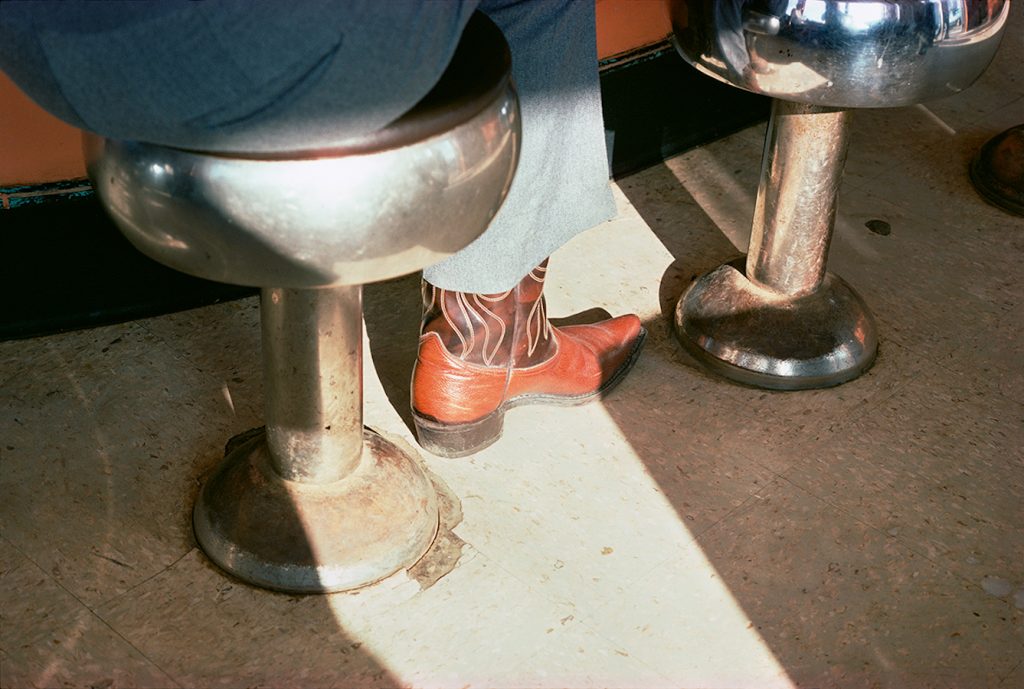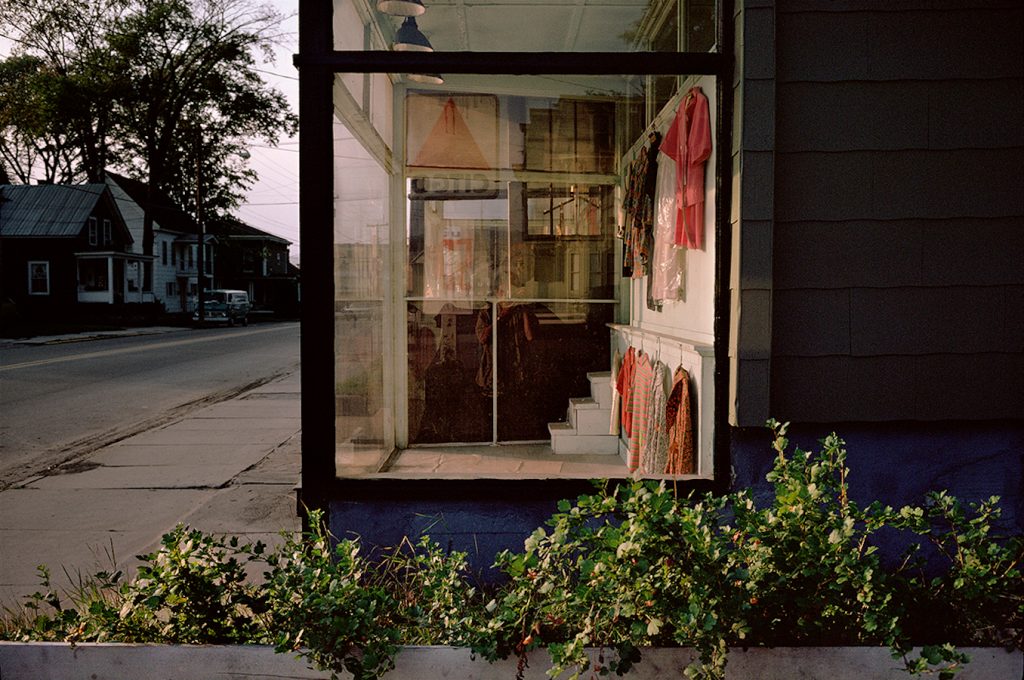In the 2017 book “Stephen Shore: Selected Works, 1973-1981,” put out right before Shore’s last grand solo MoMA show, the photographer Paul Graham writes, “When writing about photography, a constant temptation is to weave a theme from the images, to hitch them together like clanking boxcars tethered to some conceit, to suit ourselves, to suit the mood of the times, to suit the author’s whims. Yet, though there are a thousand novels in [Shore’s images], let us not do that, for all narratives are vulgar falsehoods in the end…. The still photograph on its own allows none of that. It is mute. It is multitude. You or I may see completely different worlds contained within. Its strength is precisely this.”
Yeah, well, maybe. But for “vulgar falsehoods,” how about “Don Quixote” and every novel that came after it? And how about the inescapable imaginations we bring to all kinds of works of art?
Now I’m kind of for not reading too much into photographs, though I’m also all for writing about photobooks—looking at how they work, what makes certain books great and meaningful. And Graham’s perhaps too hasty dismissal of meaning in photographs (this by a photographer best known for creating small, elliptical narratives in his own books) does lead to an intriguing thought: The best photobooks actually are comprised of shots that easily turn into a plethora of stories, little novels on every page.
And in the best of Stephen Shore’s work, a group to which we can add his most recent book, Mack’s “Transparencies: Small Camera Works 1971-1979,” little novels abound. Along with so much more
Still, let’s not discount Graham too quickly. I’m actually happy to not tell you the novel that springs to mind from, say, this Shore photograph in “Uncommon Places,” the classic of large-format photography of which “Transparencies” is the 35mm Leica shots from the same trips. It’s a shot of a room in the Sun ’n Sand Motel in Holbrook, Arizona, in August 1973, the almost perfectly made bed, the moody yellow-green light, the empty midcentury modern headboard (oh, not wholly empty: there’s a Gideon Bible on a wood slat, and two desk lamps craning down), and most telling of all, the crookedly-hung cheap painting of a river below mountains … and I won’t even begin to speculate upon the denizens of this room, what they ate, drank, thought, who they combined with and what joy or miserableness they brought into the room, and probably left with same … no, I am happy, as I am with all of Shore’s “Uncommon Places” shots, and now this wondrous addition of wider-aspect and lower-rez photos in “Transparencies,” to not read too much into them.
As in, I’m happy to enjoy the magic, no, the miracle of how Shore created such perfect shots, with so much emotion and simple order, with seemingly so little effort … how all that driving around America in gas guzzlers, taking photos of other gas guzzlers, back in the 1970s became manifest in such a strong series of photos … a series that, as “Transparencies” now proves, appears nearly inexhaustible.
Yet my imagination keeps working. So here’s the deal. You should get a copy of “Transparencies” and look deep into these casual photos yourself and see what happens, enjoying the aesthetic pleasure, that special tingle of a perfectly (yet unexpectedly) framed photograph. I admit, not every photo in the book gives rise to its own short story, though many are rich and ripe enough to spur one’s imagination. Let me describe a few of the photos as clearly and unembellished as I can, then see if you might create a short story or little novel around them; or at least, pace Graham, have to actively resist the impulse.
Shore has always been a master of color composition, and that’s the case throughout “Transparencies.” On page 29 we find a shot of a small outdoor house with a gray shingle roof, a fake red chimney, white clapboard, green trim, a flock of daisies taller than the house, and in the door and the window pale-faced blonde dolls. What? There’s another building next to it, its gray roof and weather vane above a cupola positioned exactly right in relation to our doll house. And again, the doll house has to be four feet tall at least, and it’s stocked with the two dolls. Just staring out there at us in full Gothic glory … wait, is William Faulkner clacking away on his Remington typewriter to shape this shot?
Further along, page 111, the photo is almost fully filled with a red-burgundy car hood, and in its center is a foot-high plastic-model wedding canopy with a plastic bride and groom in it. Arrayed behind this is a row of carnations, and before it longer green carnation stalks with the flowers cropped from the photo. The wedding centerpiece is held down by Scotch tape, and reflected in the car’s hood … and that’s it. Look at it a long while, then close your eyes. Can’t you just see the bride’s dress, her bouffant hairdo, the groom with slicked-back red hair and a sunburn, stuffed into a rented three-piece suit. They’re both pretty nervous. Their relatives are whooping it up. And then they have to awkwardly drive off in a car with all this wedding regalia on their front hood.
I’m not going on about this because I believe Shore himself is after a novel in every photo. Far from it. I’m doing so because that’s one way photographs can work. (Look at Graham’s quote above, even he admits “there are a thousand novels in” Shore’s photos.) But that’s part of what makes them great. All photos by definition lock down one moment in time, but in the greatest photos it’s the right moment, redolent with meaning, implying a whole series of moments; and if those moments hold together, you have … a story. Likewise, if you get a tiny sliver of a picture, but it’s the right shard, as with the cover photo of a tan and brown-filigreed cowboy boot in a shaft of light at a booth in a diner, the muted stainless steel stool and the gentleman’s slit-back-pocket blue polyester pants vivid, a blur of the diner window and two other customers reflected in the next stool over … well, just this little piece of the whole picture and you can easily see the daily specials on the wall; Flo, the waitress, pouring a cup of coffee; the local paper open on the counter; and the breakfast sitting before him. (I’m betting breakfast, just as in Shore’s timeless image of pancakes, cantaloupe, milk, and water glass that appears in “Uncommon Places,” as well as on a T-shirt I bought a few years back from Uniqlo.)
Just that one little flash of boot.
One aspect I find remarkable with “Transparencies” is that, as I said before, these are the 35mm shots taken when he was doing the large-format work for “Uncommon Places.” (More on this in Part Two of my piece on “Transparencies.”) I’m the first to admit I’m not a camera geek, but apart from some quick shots probably taken from a car window early on in the book, I don’t see all that much difference in the quality of the shooting here in “Transparencies.” (Though on the printed page the greater detail of the original “Uncommon Places” is spectacular.) The deal is, a large-format camera is soooo deliberate, a handheld Leica something you can just fling around. But as always, it’s the eye that counts, and Shore’s eye in these photos is at the top of his game.
One of my favorite photos ever is Shore’s “Uncommon Places” shot of the corner of Beverly and La Brea in L.A., the one with the looming Chevron/Standard sign. I once had the chance to ask Shore how he took that picture, meaning specifically what his day was like. He said he was up early and at the corner, and that he spent a long time—as long as needed—moving the camera an inch here, an inch there until everything was framed perfectly. He even had a checklist he ran through, to make sure he’d considered every aspect of the photo; that he was being that deliberate.
Then, finally … snap.
And it is a perfect picture. The longer you look at it, the more perfect it becomes. Nothing falls out, nothing seems extraneous, every rectangular sign fits the others in just the right way, and yet … it’s just a street corner in Los Angeles in 1975.
Same with most of the shots in “Transparencies.” There’s a street scene in San Francisco looking down Columbus Avenue, the recently erected Transamerica Pyramid to the left, a yellow sign jutting out from a building to the right that reads “House of Ecstasy.” As with the Beverly–La Brea shot, every car, building, sign, even the orange Union 76 ball in the distance is just where it should be.
Which to me makes “Transparencies” as strong and important a photobook as “Uncommon Places.”
And it doesn’t get better than that.
Transparencies: Small Camera Works 1971-1979 by Stephen Shore can be purchased here.
Robert Dunn is a writer, photographer, and teacher. His latest novel is Savage Joy, inspired by his first years in NYC and working at The New Yorker magazine. His photobooks OWS, Angel Parade, Carnival of Souls, and New York Street are in the permanent collection of the libraries of the Museum of Modern Art and the International Center of Photograph (more info on Dunn’s own photobooks here; prints of his work can be ordered here, follow his instagram here). Dunn also teaches a course called “Writing the Photobook” at the New School University in New York City.






